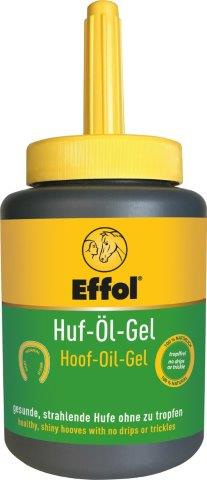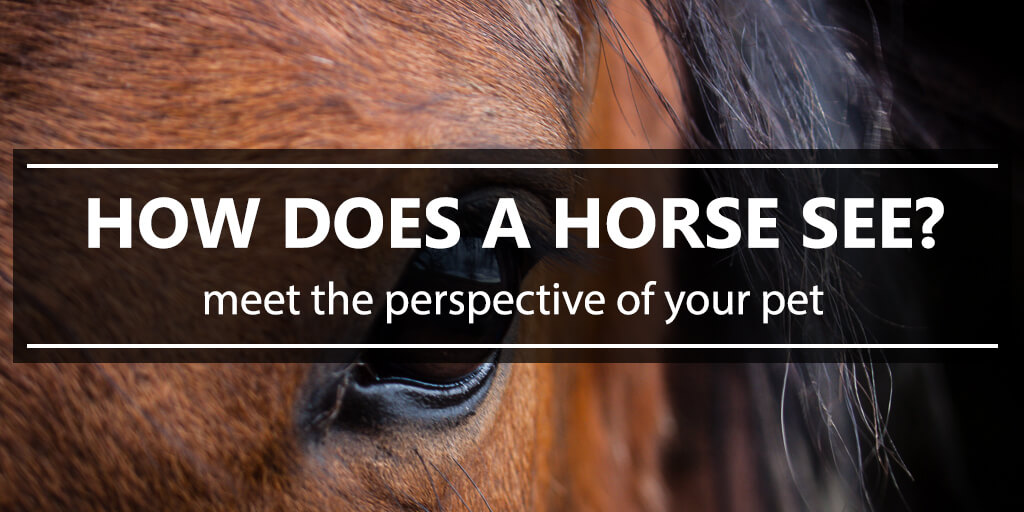 background source: gerbenvandyk.com
background source: gerbenvandyk.com
Horse belongs to the group of mammals having the biggest eyes. They are approximately 1,5 times bigger than eyes of an adult human. But how does a horse really see? Does he have the ability of differentiating colours? Does he see a rider on his back? We will try to answer all these questions.
Physiology - a bit about the structure and functioning of the horse's eye
Horse's eyeball consists of three membranes: outer (fibrous) that consists a cornea; middle (vascular) that consists the iris, and inner - namely retina. The mentioned cornea is a transparent part of the eyeball, through which you can see the iris and the pupil. The cornea is vascularised, and its function is to focalise the solar radiation. As an extension of sclera, the outer fibrous layer of an eyeball, it provides structural continuity and protects the content inside the eyeball. The vascular membrane consists ligaments that hold the lens, which function is to focalise the light on the retina. The retina consists of visual receptors - and that allows vision.
Horse's eyes are situated on both sides of his head, which is why he sees almost everything on the back and on the sides - the vision is flat and out of focus. Much clearer he can see what is in a triangle in front of his muzzle (three-dimensional sharp picture). Behind the horse, exactly in the tail's line, there is the so-called blind spot - space that the horse cannot see at all. Thus, the constant reminding to the entrants, that you cannot approach the horse from behind without proper warning, because the animal might react instinctively - out of panic and shock, wanting to defend himself, he might "present" a kick.

Visual field of a horse with his muzzle up and of a human - view from above. | orange - field of binocular vision; grey - field of monocular vision; white - blind spot
Structure of the eye and the way the horses see are results of the fact that he, as a herbivore might have fall victim to other animals - predators, so the wide, round field of vision was essential to run away in time. With both eyes, the horses see only in direction under their noses and not dead ahead, so there is another blind spot, a slight one, right ahead the horse's forehead. The animal is not capable of seeing somebody standing near his muzzle. The horse, wanting to see the person, has to tilt his head left or right, or take a step back. This kind of reaction should not be punished, then, and treated as disobedience for example during presentation of the horse in front of the panel of judges or veterinarians.
The blind spot in front of the horse's muzzle is spread from the horse's eyes' distance up to around 130 cm on the ground. If the animal wants to see sharp and clear picture of something that lies on the ground, for example poles, he has to lower his neck and head.
When the horse browses, his sight is directed towards the ground, and the field of vision is restricted to monocular. When the animal sees something, he raises his head so to see binocular - panoramic. The horse's big eye is an asset, as it allows him to see even the slightest movement and that is why the horses are anxious on windy days.
Many researches and observations of the horses have lead to conclusion that what the horse see with his one eye, for example the right one, doesn't always reach the left brain. That is why the horses acquire certain habits and some of the activities, such as saddling are accepted only when done from a certain side, because that is how they have learnt that. It also explains why some elements and exercises the horse is capable of understanding only on one side. While working with young horses, it is very often that they easily learnt how to approach an item and not be afraid of in from one side, but being on the other equals problem. The horse starts being afraid of a thing that should be well-known to him.
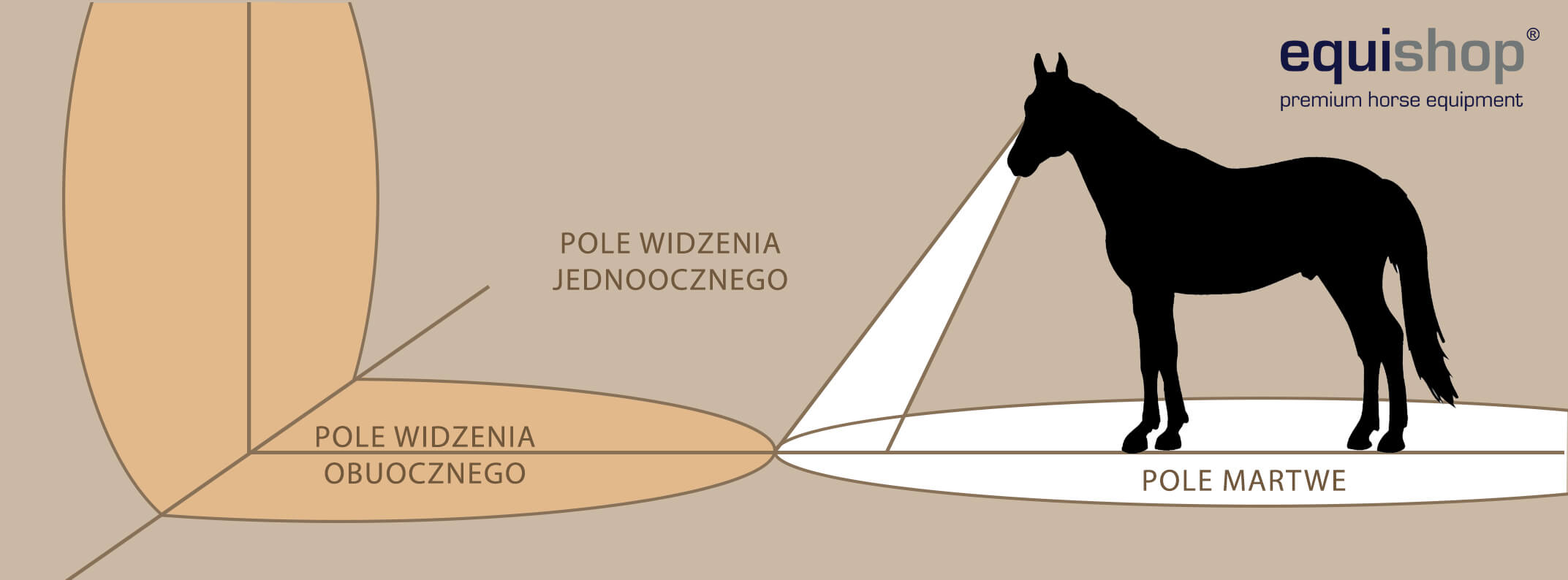
Visual field of a horse with raised head - side view | orange - field of binocular vision; grey - field of monocular vision; white - blind spot
Horses see movement in a sharp way, even smaller object that quickly change their position; that is why the horse might get scared on a flying bird or running mouse. Objects that move much slower are much harder to notice - which explains why predators creep and move slowly before they attack.
It's also been proven that the horse's eye is structured in such a way that the registered vision is enlarged by around 50% compared to our own - human perception. Among others, that is why the horse is scared by things that seem funny to us. We see a little plastic bag or a bottle. The horse spots a big moving object, which might be dangerous to him.
Horse's visual field during dressage
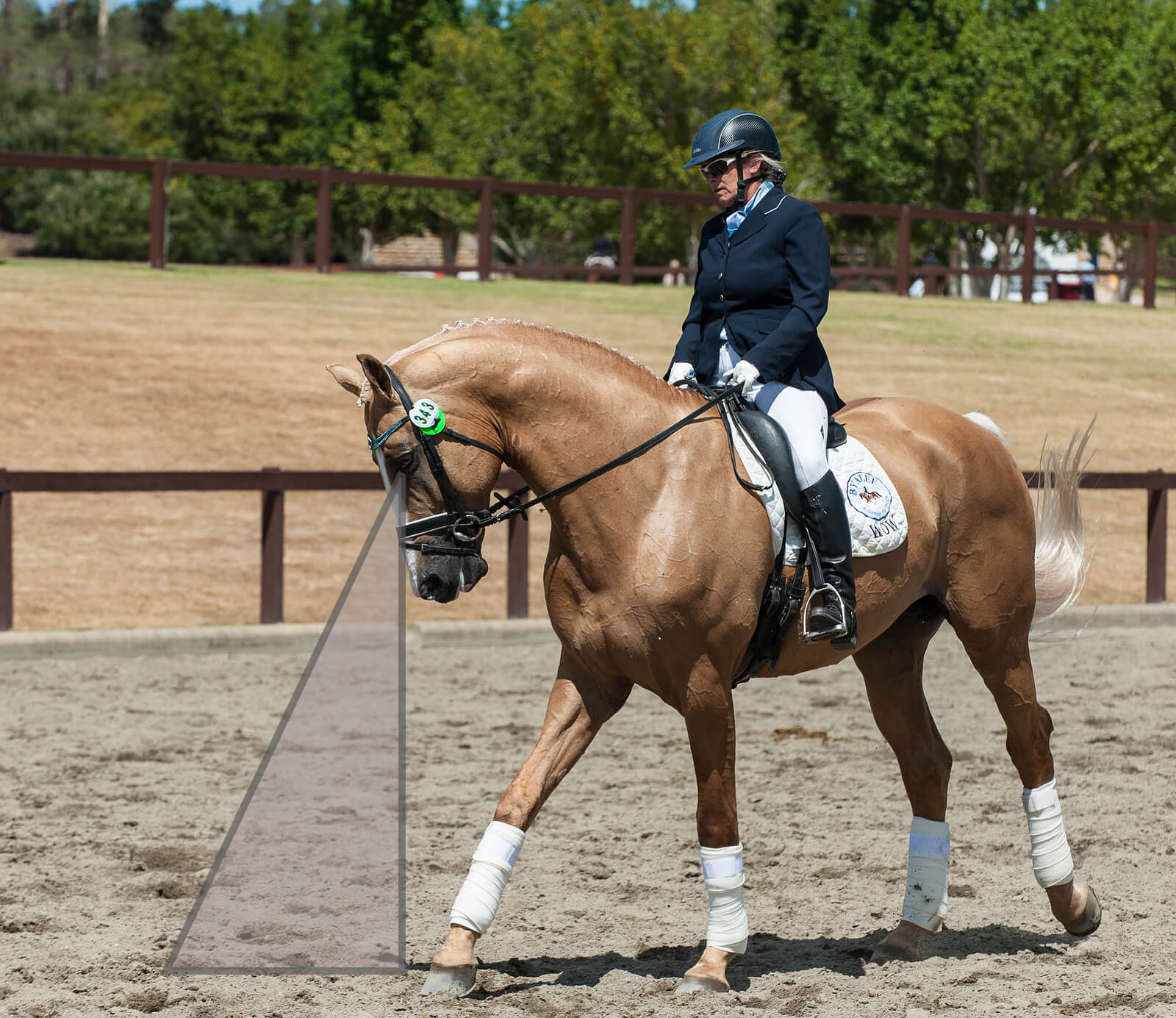
background source: flickr.com
During full collection, the horse has his head placed vertically against the ground and he may not see what is in front of him, and only what is below his nose. The animal, walking "on a bit" has to rely on the rider and direction he or she chooses, as the horse walks practically gropingly. Sometimes the horses might collide during a training if they walk in the opposite directions, not seeing each other.
Horse's visual field during jumping
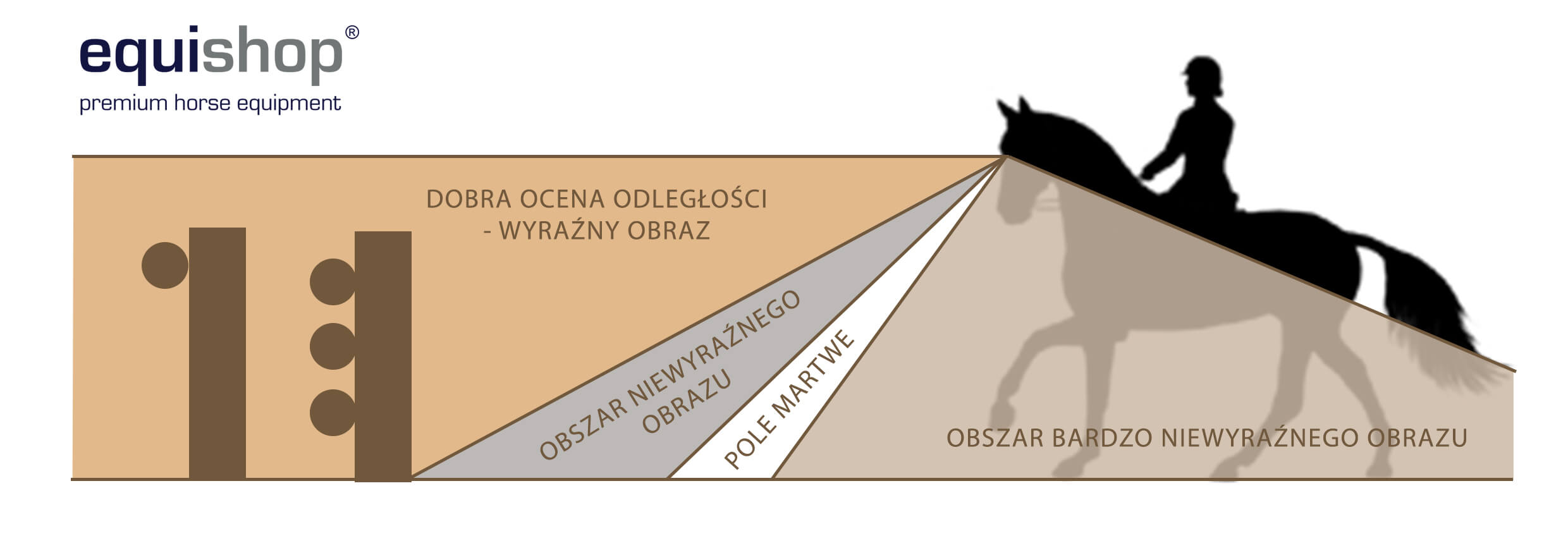
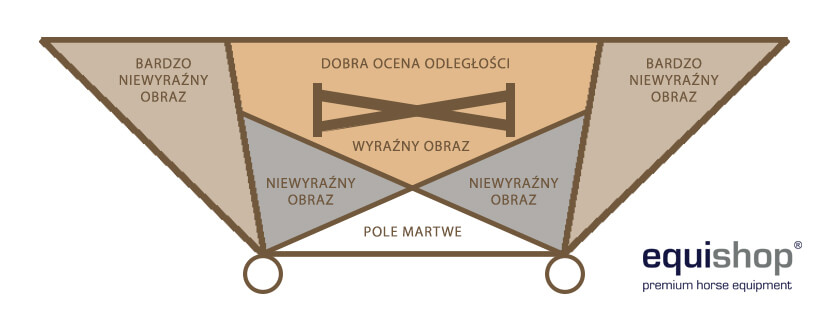
Visual field of a horse on a few fouls before a jump | orange - good distance assessment, sharp vision; blue - blurred vision; grey - very blurred vision; white - blind spot
While observing the horses during jumping, it's easy to spot that during approaching the obstacle they raise their heads. They do that to get better binocular vision and orientate themselves on what exact height and width the obstacle is (using both eyes). When the animal is in the place of jump, he can no longer see the obstacle and can rely only on the things he memorised while looking at it from a distance - so in fact, he jumps by heart. Horses, in order to help themselves, try to raise their heads in the last moment to see better how they jump. It is the reason for which it is good to give them a hint before the obstacle - very helpful, especially for the younger horses, because it will help them find the moment of jump.
Now we know how important the steed's memory is for the jumping, and why we should focus on perpetuation by the means of repetition.
Does the horse see his rider?
Horses are the classic far-sighted beings, although they are considered to have poor sight. It might seem that due to the very wide visual field, they should see the person sitting on their back, however it's not the case, because the rider is in their blind spot.
How well does the horse see details?
An experiment has been conducted. Horses were taught how to pick a door with stripes painted on it, in contrast to that without stripes, and the right choice were awarded with treat. They differentiated thickness of the stripes, until they couldn't tell them from the greys. The results proved that horses can see at least as good as we can, if not better. Using the Snellen's scale to compare their sight to ours, it turned out that people can see 20/20 (that means that they can see an object (reading from a board) and a person from 20 feet), and horses can see 20/33 (for comparison: dogs 20/50, cats 20/75, rats 20/300).
Vision at night
Research has shown that horses see at leat two times better at night than people - it is probably due to the aforementioned increased alertness, so they can protect themselves from predators during night grazing.
Horses much better stand intense light, so they are not blinded by the sunlight, especially the one reflecting from snow. However, those animals slower adjust to light changes, so they can squint while light in the stable is rapidly turned on if it was all dark before, or he may have difficulties with jumping over an obstacle that is on the border of light and shadow.
Coloured vision
Seeing and differentiating colour is still a point at issue among researchers. Some state that horses can better see warm colours and vivid tones, but they have problems with seeing dark, deep colours.
In order to find out how horses see colours, scientists have conducted proper tests that showed that they can always tell the difference between red and blue, regardless on which background the given colour is seen. Perceiving the colour yellow and green has also been checked, placed on a lighted background and it turned out that some of the horses had troubles telling one from another.
We can draw our own conclusions while watching jumping competitions. Parkour is more difficult for the horses, because the obstacles are placed from monochromatic poles, for example dark blue, or wooden. Much easier for the horse is to ride on a track that has obstacles in very contrasting colours and they are places by turns (eg. red-yellow-white).
We cannot understand the horse and act properly with him until we get to know the amazing properties of his eyes and the way they see. We hope that due to our article, your consciousness will increase, and you'll become more patient with your steed, understanding his actions and not punishing him in situations that he's acting completely instinctive.



 background source: gerbenvandyk.com
background source: gerbenvandyk.com Visual field of a horse with his muzzle up and of a human - view from above. | orange - field of binocular vision; grey - field of monocular vision; white - blind spot
Visual field of a horse with his muzzle up and of a human - view from above. | orange - field of binocular vision; grey - field of monocular vision; white - blind spot Visual field of a horse with raised head - side view | orange - field of binocular vision; grey - field of monocular vision; white - blind spot
Visual field of a horse with raised head - side view | orange - field of binocular vision; grey - field of monocular vision; white - blind spot background source: flickr.com
background source: flickr.com
 Visual field of a horse on a few fouls before a jump | orange - good distance assessment, sharp vision; blue - blurred vision; grey - very blurred vision; white - blind spot
Visual field of a horse on a few fouls before a jump | orange - good distance assessment, sharp vision; blue - blurred vision; grey - very blurred vision; white - blind spot